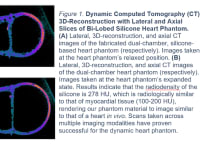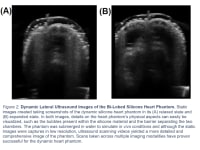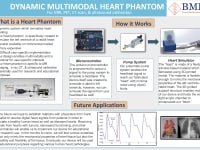
In recent decades, cardiac phantoms have proven instrumental in empowering researchers and physicians to develop improved myocardium imaging protocols. Fostering innovation via their reproducibility, durability, and ability to conveniently map various disease pathologies, phantoms are able to bypass problems inherent in using natural hearts for protocol development (legal limitations, transportation, longevity, etc.). The capacity of phantoms to calibrate imaging equipment has made them critical in developing more accurate imaging protocols that ultimately enable personalized medical procedures specific to a patient’s needs. However, phantoms are typically only compatible with a single mode of imaging, thereby constricting comprehensive systems analyses by necessitating several costly phantoms and increasing the probability for inconsistency.
Our heart phantom is a novel improvement of commercially available heart phantoms as our device is multimodal, dynamic, modular, and inexpensive. The phantom’s multimodality is a derivative of materials tested to be X-ray CT, fMRI, and ultrasound compatible, allowing heart pathologies to be imaged and quantified through several avenues. Operating as a stepper motor moves a syringe via a crank-slider mechanism, the phantom mimics a heartbeat by causing fluids to fill or leave the bi-lobe silicone phantom design. This dynamic nature of the phantom lends it the ability to calibrate imaging techniques to the movement of tissue. By contrast, modern heart phantoms tend to be static and thereby incompatible for time-dependent cardiac tissue simulation.
The phantom also exhibits modularity modelling different cardiac conditions. Specifically, incorporating physical heart deformities in phantom design and variable heart signal input simulate heart pathologies. Furthermore, our phantom is inexpensive relative to commercially available heart phantoms. Coming to under $250 in material costs and gauged to a commercial price of $330 incorporating assembly costs and profit, the phantom is more economically accessible than traditional market phantoms costing several thousand dollars.
Our heart phantom holds utility in medicine, research, and education. Medically, the phantom can help calibrate imaging machinery by providing baseline test cases for heart functionality, leading to more personalized and accurate imaging. In research, the phantom’s dynamic nature enables the simulation of various disease pathologies on heart functionality while its compatibility with different imaging modalities allows these pathological effects to be quantified generally and individually. With imaging technicians comprising the phantom’s primary user base, manufacturing and distribution would therefore be geared heavily towards MRI, CT, and ultrasound machinery distributors. Finally, the phantom can reach medical educators and students to depict the heart’s fluid mechanics without requiring a flesh heart.
Presently, approximately 2,500 MRI machines are sold worldwide annually with roughly 36,000 units already owned. As manufacturing costs for imaging machinery continue to fall, facilities will have increased access to such equipment. Utilizing imaging equipment to maximize personalized care requires stringent calibration measures, a task greatly eased by heart phantoms. With traditional phantom design characterized as static, unimodal, and prohibitively expensive, phantoms have yet to actualize their calibration and imaging potential. Thus, our heart phantom holds the potential to leave a resounding impact upon medical imaging and research by providing a cost-effective solution to heart phantom design.
Video
-
Awards
-
 2016 Top 100 Entries
2016 Top 100 Entries
Like this entry?
-
About the Entrant
- Name:Hiba Shahid
- Type of entry:teamTeam members:Hiba Shahid, Joshua Lew, Pierce Hadley, Bara Saadah, Nathan Cornwell, Viraat Goel, Joshua Au, Teresa Yang, Hugh Yeh, Alex Hasnain, Jacob Haynie, Boeun Hwang.
- Software used for this entry:Blender, Autodesk
- Patent status:none








